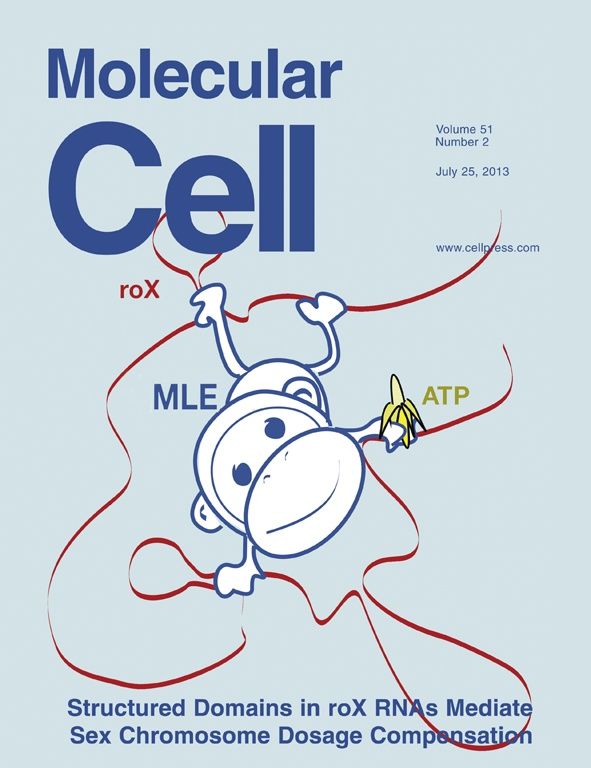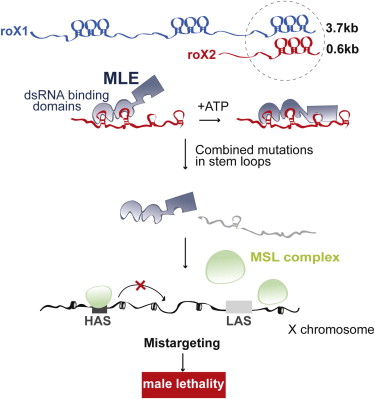博文
MC封面文章—— X Chromosome Dosage Compensation
|||

Epigenetic phenomenon of dosage compensation in Drosophila is mediated by the male-specific lethal (MSL) complex, which contains two large noncoding roX RNAs inDrosophila. How these RNAs interact with the MSL proteins remains poorly understood. In this study, Ilik et al. (156–173) use in vivo crosslinking and structural probing methodologies to reveal that roX RNAs contain clustered domains that form multiple protein-binding sites for the MSL complex. MLE RNA/DNA helicase, a component of the MSL complex (depicted as a small monkey) has various domains (hands and feet) with which it can interact with different regions in roX RNAs (depicted as red ribbon). Furthermore, by utilizing an energy source ATP (depicted as a banana), MLE can gain access to additional regions of the RNA. The study shows that stem loops in roX RNAs have overlapping functions as only combined mutations lead to severe male lethality, underscoring the importance of these interaction for X chromosome regulation. Cover art by Tugce Aktas.
Summary
Dosage compensation in Drosophila is an epigenetic phenomenon utilizing proteins and long noncoding RNAs (lncRNAs) for transcriptional upregulation of the male X chromosome. Here, by using UV crosslinking followed by deep sequencing, we show that two enzymes in the Male-Specific Lethal complex, MLE RNA helicase and MSL2 ubiquitin ligase, bind evolutionarily conserved domains containing tandem stem-loops in roX1 and roX2 RNAs in vivo. These domains constitute the minimal RNA unit present in multiple copies in diverse arrangements for nucleation of the MSL complex. MLE binds to these domains with distinct ATP-independent and ATP-dependent behavior. Importantly, we show that different roX RNA domains have overlapping function, since only combinatorial mutations in the tandem stem-loops result in severe loss of dosage compensation and consequently male-specific lethality. We propose that repetitive structural motifs in lncRNAs could provide plasticity during multiprotein complex assemblies to ensure efficient targeting incis or in trans along chromosomes.


SHAPE Structural Analysis Reveals the Architecture of roX1 and roX2(A) SHAPE analysis of the R1H1 region of roX1. Full-length roX1 RNA was in vitro transcribed and treated with or without SHAPE reagent, (± NAI). cDNAs were reverse transcribed from the modified RNA to identify modified, flexible bases. Sequencing lanes identify the base position + 1, and the (–) NAI lane identifies spurious reverse transcription stops that are modification independent. The SHAPE reactivity score for each base is calculated by integrating gel band intensities, subtracting background (–NAI), and normalizing to top peaks. Paired bases have low reactivity (gray), and flexible unpaired bases have high reactivity (increasing from yellow to orange to red).(B) SHAPE-derived structural domains of roX1. From the SHAPE reactivity profile for the 3′-terminal domain of roX1, a structure model is built. The R1H1 structure is derived from the SHAPE gel in (A). For each structure, reactive bases are present in bulges and the terminal loop, whereas the helix of this stem-loop is characterized by stretches of low reactivity.(C) Structure model of the entire 3′ terminus of roX1. The 3′ terminus of roX1 is organized into three stable helices, two of which contain a core roX box motif (R1H1 and R1H2). The A-bulge likely participates in long-range base pairing with distal U-rich regions of roX1 that were not interrogated here. The very 3′ end lacks any well-defined secondary structure.(D) The SHAPE profile of the R2H1 region of roX2. The R2H1 domain of roX2 exhibits light-heavy-light modification, characteristic of a stable stem-loop.(E) SHAPE-derived structural domains of roX2. SHAPE of roX2 exon-3 resolved many stable secondary structures. Three of the helices contain roX box-like motif (R2H1-3), and three contain the roX box motif (R2H4-6).(F) Structure model for roX2 exon-3. roX2 exon-3 is arranged into stable structural domains that are linked together by a flexible backbone.
https://blog.sciencenet.cn/blog-982855-712051.html
上一篇:PNAS文章——Rb与SSC新观点
下一篇:瓶颈
全部作者的其他最新博文
- • 一个悲伤的故事
- • 我怀念的
- • 巴德年院士科大报告语摘——受益匪浅
- • 这是个黑童话么?——MC封面文章
- • 你是猴子请来的啥?